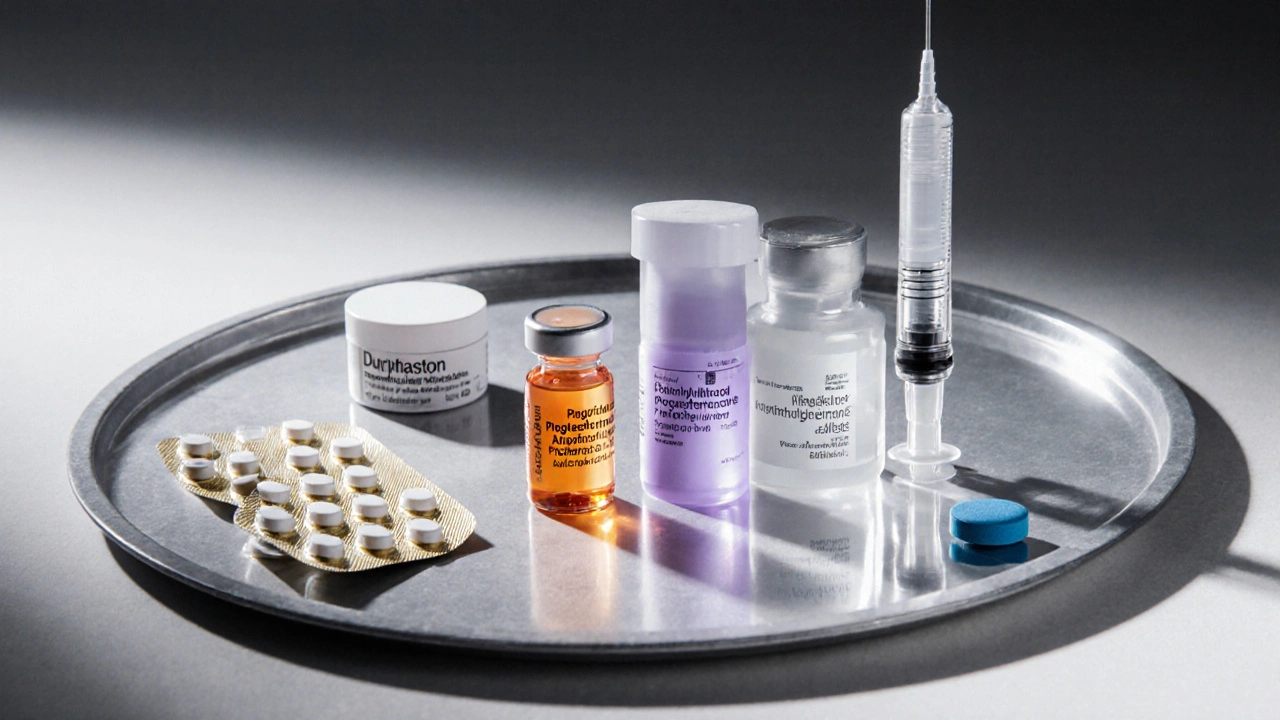Progesterone Treatment Decision Tool
Find Your Best Progesterone Option
This tool helps you identify the most suitable progesterone treatment based on your primary goal, side effect tolerance, administration preference, and budget.
When doctors talk about progesterone‑based treatments, Duphaston is often the name that pops up. Duphaston is a brand‑name tablet that contains dydrogesterone, a synthetic progestogen designed to mimic the body’s natural progesterone while avoiding some of its metabolic drawbacks.
People facing irregular periods, threatened miscarriage, or menopause‑related symptoms frequently wonder whether Duphaston is the best choice or if a cheaper or more natural alternative would work just as well. Below we break down the most common substitutes, compare their key attributes, and give you a quick decision‑making toolkit.
How Dydrogesterone Works (and why it’s different)
Dydrogesterone belongs to the class of "retro‑progesterone" molecules. Unlike natural progesterone, it binds selectively to progesterone receptors without significant conversion to androgenic or estrogenic metabolites. That selective binding translates into:
- Better oral bioavailability (about 60‑70% versus 10‑12% for micronized progesterone)
- Lower risk of sedation or drowsiness, common with some oral progestins
- Fewer oil‑based injections or vaginal preparations needed
Common Alternatives to Duphaston
Below are the five most widely prescribed progesterone‑type medications that people compare with Duphaston:
- Micronized progesterone - a bioidentical form derived from plant sterols, usually taken orally or vaginally.
- Medroxyprogesterone acetate (MPA) - a synthetic progestin often used in hormone replacement therapy and contraceptive injections.
- Norethisterone acetate - another synthetic progestin popular for treating endometriosis and menstrual‑related pain.
- Depot progesterone (hydroxyprogesterone caproate) - an injectable formulation used mainly to prevent preterm birth.
- Progesterone‑containing combined oral contraceptives (COCs) - where progesterone is blended with estrogen for birth control and cycle regulation.
Side‑Effect Snapshot
Even though all these agents act on the same receptor, the side‑effect profiles differ because of their chemical structures and routes of administration. Here’s a quick glance:
- Dydrogesterone (Duphaston): mild nausea, breast tenderness, rare weight gain.
- Micronized progesterone: drowsiness, headaches, occasional bloating.
- MPA: increased appetite, mood swings, higher long‑term risk of osteoporosis if used continuously.
- Norethisterone: acne, slight increase in libido, occasional menstrual spotting.
- Depot progesterone: injection site pain, transient flu‑like symptoms.

Cost Comparison (UK 2025 average retail)
| Medication | Typical Dose | Form | Bioavailability (oral) | Key Indications | Average Monthly Cost (GBP) |
|---|---|---|---|---|---|
| Duphaston (dydrogesterone) | 10‑30mg daily | Tablet | ≈65% | Threatened miscarriage, luteal‑phase support, HRT | £30‑£45 |
| Micronized progesterone | 200‑400mg nightly | Capsule / Vaginal gel | ≈12% | Menopause symptoms, infertility support | £20‑£35 |
| Medroxyprogesterone acetate (MPA) | 5‑10mg daily | Tablet / Injection | ≈80% | HRT, endometriosis, certain cancers | £15‑£25 |
| Norethisterone acetate | 5‑10mg daily | Tablet | ≈70% | Endometriosis, heavy menstrual bleeding | £18‑£30 |
| Depot progesterone (hydroxyprogesterone caproate) | 250mg IM weekly | Injection | N/A (intramuscular) | Preterm‑birth prevention | £120‑£150 (single dose) |
When Duphaston Might Be the Best Fit
If you need a pill you can swallow once a day, have a history of hormone‑sensitive skin conditions, or want a drug that doesn’t fog your mind, Duphaston often wins the vote. Its high oral bioavailability means you can achieve therapeutic levels without large doses, which keeps the pill size manageable and the cost moderate.
Women who have experienced early pregnancy loss can benefit from dydrogesterone’s ability to stabilize the uterine lining without the strong androgenic side‑effects seen in some older progestins.
Scenarios Where an Alternative Shines
- Night‑time drowsiness is a deal‑breaker. Micronized progesterone is notorious for making people sleepy; a morning‑only tablet like Duphaston avoids that.
- Financial tightness. Generic MPA and norethisterone can be 30‑50% cheaper, especially when bought in bulk.
- Vaginal administration preferred. Some women find the local delivery of micronized progesterone gel more effective for severe night sweats.
- Long‑acting protection needed. A single depot injection can cover an entire pregnancy, something oral tablets can’t match.

Decision‑Making Checklist
- Identify the primary goal: luteal‑phase support, menopause relief, or endometriosis control?
- Check your tolerance for side‑effects: do you mind mild nausea (Duphaston) or would you rather avoid any sedation (micronized progesterone)?
- Consider route of administration: oral tablet, vaginal gel, or injection?
- Compare costs based on your prescription length and insurance coverage.
- Discuss with your GP or gynaecologist any past reactions to hormonal medication.
Cross‑checking these points against the table above usually points you toward the most suitable option.
Key Takeaways
- Duphaston (dydrogesterone) offers high oral bioavailability and a relatively mild side‑effect profile.
- Micronized progesterone is the most natural but suffers from low absorption and daytime drowsiness.
- MPA and norethisterone are cost‑effective synthetic progestins with distinct hormonal footprints.
- Depot progesterone provides long‑acting coverage for specific obstetric scenarios.
- Choosing the right product hinges on your therapeutic aim, side‑effect tolerance, and budget.
Frequently Asked Questions
Can I switch from Duphaston to micronized progesterone during a pregnancy?
Yes, but you should do it under close supervision. Dydrogesterone and natural progesterone have slightly different receptor affinities, so the dose might need tweaking. Your doctor will usually repeat an ultrasound after the switch to confirm the uterine lining remains supportive.
Is Duphaston safe for long‑term menopause hormone therapy?
Clinical guidelines from the NHS and the International Menopause Society recommend dydrogesterone for women who need cyclic progesterone protection with estrogen. Long‑term data shows no increase in breast‑cancer risk when used at standard doses, but annual reviews are essential.
Why does micronized progesterone cause more sleepiness than Duphaston?
Micronized progesterone is a bioidentical molecule that crosses the blood‑brain barrier and binds to GABA‑A receptors, which can produce a sedative effect. Dydrogesterone’s structure bypasses most of these central nervous system pathways, keeping you more alert.
Can I take Duphaston if I’m on a combined oral contraceptive?
Adding Duphaston to a COC is generally unnecessary because the contraceptive already contains a progestin. However, in rare cases where a doctor wants extra luteal‑phase support (e.g., after IVF), a short course may be prescribed. Never combine without medical advice.
Which option is the cheapest for a three‑month HRT regimen?
On average, a three‑month supply of generic MPA tablets costs around £45, while Duphaston runs about £90‑£135 depending on dosage. Micronized progesterone gel sits in the middle at roughly £60‑£90. Prices vary by pharmacy and NHS prescription eligibility.

Sarah Pearce
October 14, 2025 AT 18:33Wow!! Duphaston looks like a pricey pill!!!
Ajay Kumar
October 15, 2025 AT 14:00I totally get how overwhelming the options can feel, especially when you’re juggling side‑effects and budget. The tool you shared does a solid job of breaking things down into bite‑size pieces. It’s nice to see the oral bioavailability numbers front and centre – they really matter for daily compliance. For anyone in luteal‑phase support, the Duphaston vs MPA comparison is a game‑changer. Keep the info coming, it helps a lot of us navigate the hormone maze.
Richa Ajrekar
October 16, 2025 AT 09:27While the article is fairly thorough, there are a few grammatical slip‑ups that could confuse readers – for instance “bioidentical hormone” is sometimes written without a hyphen, and “Dydrogesterone” should be capitalised consistently. Also, the table layout could benefit from a clearer header hierarchy; “Formul” is misspelled in one of the rows. As an Indian reader, I appreciate the effort but precision matters, especially in medical contexts. A quick proofread would elevate the professionalism of this piece.
Pramod Hingmang
October 17, 2025 AT 04:53Honestly this guide feels like a bright tapestry woven with data and empathy offering a vivid map for anyone hunting the right progesterone path without drowning in jargon
Benjamin Hamel
October 18, 2025 AT 00:20Let’s take a step back and examine why the hype around Duphaston might be overblown for the average patient. First, the cost advantage of generic MPA is hard to ignore when a prescription is needed for months on end. Second, the claim of “minimal sedation” is relative; many users report subtle fatigue that they attribute to their condition rather than the drug itself. Third, while high oral bioavailability sounds impressive, it also means systemic exposure is higher, potentially escalating the risk of off‑target effects. Fourth, the evidence base for Duphaston in luteal‑phase support largely hinges on small‑scale studies that may not translate to broader populations. Fifth, the convenience of a once‑daily tablet is offset by the necessity of strict timing to maintain stable plasma levels, something not required with depot injections. Sixth, the alternative vaginal micronized progesterone, though lower in bioavailability, provides targeted uterine support with fewer systemic side effects. Seventh, patients with a history of hormone‑sensitive cancers should scrutinise any progestin, including Duphaston, before long‑term use. Eighth, insurance coverage in the UK often favours cheaper options, making out‑of‑pocket expenses a real concern. Ninth, the side‑effect profile listed for Duphaston omits rare but serious events like thromboembolic complications that have been reported with other progestins. Tenth, physician bias can colour prescribing habits; some clinicians favour familiar brands over generics out of habit. Eleventh, the supplemental table could be enhanced with a cost‑per‑cycle column, giving readers clearer financial perspective. Twelfth, the user‑friendly decision tool is a nice touch, yet it assumes patients have the literacy to interpret medical terminology unaided. Thirteenth, cultural preferences play a role – in some regions, injectable or vaginal routes are more acceptable than oral tablets. Fourteenth, the article could benefit from patient testimonials to humanise the data. Finally, while Duphaston is a solid option for specific scenarios, labeling it as the “best fit” across the board oversimplifies a nuanced therapeutic landscape.
Christian James Wood
October 18, 2025 AT 19:47Honestly, the enthusiasm for Duphaston borders on cult‑like devotion, and that’s a problem because it blinds us to the cheaper, equally effective alternatives that sit right under the radar. When you dissect the pharmacodynamics, you’ll find that Duphaston’s selective receptor binding isn’t some mystical miracle – it’s simply a design choice that still triggers the same downstream pathways as older progestins, with comparable risk profiles. Moreover, the marketing narrative that touts “no drowsiness” ignores the fact that sleepiness can be a symptom of the underlying condition, not the medication, leading to misplaced credit. If you’re paying £45 a month for a brand‑name tablet, ask yourself whether that expense translates into a measurable clinical benefit beyond what a generic MPA can deliver for a fraction of the price. The article also neglects to discuss drug‑drug interactions, a critical oversight for patients on multifaceted hormone regimens. And let’s not forget the environmental impact of manufacturing proprietary pharmaceuticals versus bulk generic production. Bottom line: Duphaston is not the holy grail, it’s one tool in a larger toolbox, and clinicians should weigh all variables before defaulting to the pricier option.
Rebecca Ebstein
October 19, 2025 AT 15:13Great job on pulling all the info together, it really makes the decision process less scary! I love how you highlighted the side‑effect differences – that’s super helpful for people like me who get nervous about feeling drowsy. The cost breakdown is also a lifesaver, especially when insurance coverage can be a maze. Keep up the awesome work, and maybe add a quick “who is this for?” chart next time? :)
Artie Alex
October 20, 2025 AT 10:40From a pharmacoeconomic standpoint, the comparative analysis delineated herein warrants a granular cost‑utility evaluation, particularly when juxtaposing the incremental quality‑adjusted life year (QALY) gains associated with dydrogesterone versus the established generic agents. The utilization of a decision‑support algorithm, albeit rudimentary, could be augmented with probabilistic sensitivity analyses to ascertain robustness across heterogeneous patient cohorts. Moreover, the omission of pharmacokinetic variability attributable to CYP450 polymorphisms may engender suboptimal therapeutic indexing. In sum, the manuscript provides a commendable scaffold but necessitates further methodological rigour to meet the evidentiary thresholds demanded by contemporary clinical governance frameworks.
abigail loterina
October 21, 2025 AT 06:07If you’re feeling unsure, remember that every body reacts differently – don’t be afraid to discuss the options with your doctor and try what feels right for you.
Roger Cole
October 22, 2025 AT 01:33Sound advice – balance efficacy, side effects, and budget before deciding.
Krishna Garimella
October 22, 2025 AT 21:00Choosing a progesterone isn’t just a medical decision; it’s a moment where you assert agency over your body’s rhythm. The pathway you pick can become a metaphor for how you navigate other life choices – evaluating goals, tolerances, and resources before committing. Let the decision tool be a compass, but trust your inner voice as the ultimate guide. When you align the treatment with your personal narrative, the outcome feels more empowering.
nalina Rajkumar
October 23, 2025 AT 16:27Love the clear table 😍 the cost numbers help a lot 🙌 hope more people see this
Michael Barrett
October 24, 2025 AT 11:53While the article does a decent job outlining options, it overlooks the critical aspect of patient adherence-how many will actually take a daily tablet versus a weekly injection? Moreover, the cost analysis fails to incorporate pharmacy discount programs; thus the presented figures may be misleading. A holistic view must also factor in real‑world effectiveness, not just bioavailability percentages.
Inma Sims
October 25, 2025 AT 07:20Ah, the timeless quest for the “perfect” progesterone – as if a single molecule could resolve every nuanced hormonal dilemma. One might suggest a modest pause to reflect on whether the pursuit of an elusive ideal is, perhaps, a tad quixotic. Nonetheless, your thorough comparison does provide a respectable baseline for those intent on navigating the labyrinthine options.
Gavin Potenza
October 26, 2025 AT 02:47It’s fascinating how hormone therapy mirrors the broader human experience: we weigh pros and cons, seek balance, and hope for harmony. Your tool feels like a modern oracle, translating complex pharmacology into everyday language – cheers to that! Just remember that personal anecdotes often add the spice missing from raw data.
Virat Mishra
October 26, 2025 AT 21:13This piece tries too hard to sound clinical but ends up sounding like a textbook snooze fest it lacks the human touch patients need
Daisy Aguirre
October 27, 2025 AT 16:40What a vibrant guide! Your breakdown shines a bright light on the often‑confusing world of progesterone choices, and I’m sure readers will feel more empowered to pick what truly fits their lives. Keep spreading the positivity!
Natalie Kelly
October 28, 2025 AT 12:07Good info, short and sweet.
Tiffany Clarke
October 29, 2025 AT 07:33Another hormone rant, same old hype.
Sandy Gold
October 30, 2025 AT 03:00One might argue that the entire comparative framework is reductive, ignoring the epistemological complexities of endocrine modulation and the sociocultural narratives entwined with hormone therapy.